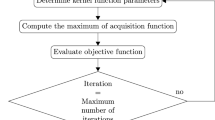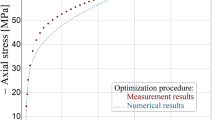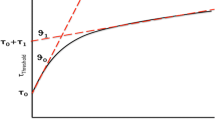Abstract
Due to the growing trend towards miniaturization, small-scale manufacturing processes have become widely used in various engineering fields to manufacture miniaturized products. These processes generally exhibit complex size effects, making the behavior of materials highly dependent on their geometric dimensions. As a result, accurate understanding and modeling of such effects are crucial for optimizing manufacturing outcomes and achieving high-performance final products. To this end, advanced gradient-enhanced plasticity theories have emerged as powerful tools for capturing these complex phenomena, offering a level of accuracy significantly greater than that provided by classical plasticity approaches. However, these advanced theories often require the identification of a large number of material parameters, which poses a significant challenge due to limited experimental data at small scales and high computation costs. The present paper aims at evaluating and comparing the effectiveness of various optimization techniques, including evolutionary algorithm, response surface methodology and Bayesian optimization, in identifying the material parameter of a recent flexible gradient-enhanced plasticity model developed by the authors. The paper findings represent an attempt to bridge the gap between advanced material behavior theories and their practical industrial applications, by offering insights into efficient and reliable material parameter identification procedures.

















Similar content being viewed by others
References
Aifantis EC (1984) On the Microstructural Origin of Certain Inelastic Models. J Eng Mater Technol 106:326–330
Gurtin ME (2002) A gradient theory of single-crystal viscoplasticity that accounts for geometrically necessary dislocations. J Mech Phys Solids 50:5–32
Panteghini A, Bardella L, Niordson CF (2019) A potential for higher-order phenomenological strain gradient plasticity to predict reliable response under non-proportional loading. Proc Royal Soc A Math Phys Eng Sci 475:20190258
Forest S (2020) Continuum thermomechanics of nonlinear micromorphic, strain and stress gradient media. Phil Trans R Soc A Math Phys Eng Sci 378:20190169
Jebahi M, Cai L, Abed-Meraim F (2020) Strain gradient crystal plasticity model based on generalized non-quadratic defect energy and uncoupled dissipation. Int J Plast 126:102617
Yuan H, Chen J (2001) Identification of the intrinsic material length in gradient plasticity theory from micro-indentation tests. Int J Solids Struct
Abu Al-Rub RK, Voyiadjis GZ (2004) Analytical and experimental determination of the material intrinsic length scale of strain gradient plasticity theory from micro- and nano-indentation experiments. Int J Plast 20:1139–1182
Peerlings RHJ, Geers MGD, de Borst R, Brekelmans WAM (2001) A critical comparison of nonlocal and gradient-enhanced softening continua. Int J Solids Struct 38:7723–7746
Gurtin ME, Anand L, Lele SP (2007) Gradient single-crystal plasticity with free energy dependent on dislocation densities. J Mech Phys Solids 55:1853–1878
Poh LH, Peerlings RHJ, Geers MGD, Swaddiwudhipong S (2011) An implicit tensorial gradient plasticity model - Formulation and comparison with a scalar gradient model. Int J Solids Struct 48:2595–2604
Pardoen T, Massart TJ (2012) Interface controlled plastic flow modelled by strain gradient plasticity theory. Comptes Rendus - Mecanique 340:247–260
Fleck NA, Hutchinson JW, Willis JR (2015) Guidelines for Constructing Strain Gradient Plasticity Theories. J Appl Mech 82:071002
Bayerschen E, Böhlke T (2016) Power-Law Defect Energy in a Single-Crystal Gradient Plasticity Framework: A Computational Study. Comput Mech 58:13–27
Petryk H, Stupkiewicz S (2016) A Minimal Gradient-Enhancement of the Classical Continuum Theory of Crystal Plasticity. Part I: The Hardening Law. Arch Mech 68:459–485
Martínez-Pañeda E, Niordson CF, Bardella L (2016) A Finite Element Framework for Distortion Gradient Plasticity with Applications to Bending of Thin Foils. Int J Solids Struct 96:288–299
Lebensohn RA, Needleman A (2016) Numerical implementation of non-local polycrystal plasticity using fast Fourier transforms. J Mech Phys Solids 97:333–351
Panteghini A, Bardella L (2020) Modelling the cyclic torsion of polycrystalline micron-sized copper wires by distortion gradient plasticity. Philos Mag 100:2352–2364
Russo R, Girot Mata FA, Forest S, Jacquin D (2020) A Review on Strain Gradient Plasticity Approaches in Simulation of Manufacturing Processes. J Manuf Mater Process 4:87
Cai L, Jebahi M, Abed-Meraim F (2021) Strain Localization Modes within Single Crystals Using Finite Deformation Strain Gradient Crystal Plasticity. Crystals 11:1235
Jebahi M, Forest S (2021) Scalar-based strain gradient plasticity theory to model size-dependent kinematic hardening effects. Continuum Mech Thermodyn
Jebahi M, Forest S (2023) An alternative way to describe thermodynamically-consistent higher-order dissipation within strain gradient plasticity. J Mech Phys Solids 170:105103
Liu K, Melkote SN (2005) Material Strengthening Mechanisms and Their Contribution to Size Effect in Micro-Cutting. J Manuf Sci Eng 128:730–738
Guha S, Sangal S, Basu S (2014) Numerical investigations of flat punch molding using a higher order strain gradient plasticity theory. Int J Mater Form 7:459–467
Nielsen K, Niordson C, Hutchinson J (2014) Strain gradient effects in periodic flat punch indenting at small scales. Int J Solids Struct 51:3549–3556
Nielsen KL, Niordson CF, Hutchinson JW (2015) Rolling at Small Scales. J Manuf Sci Eng 138
Zhang X, Aifantis K (2015) Interpreting the internal length scale in strain gradient plasticity. Rev Adv Mater Sci 41:72–83
Liu D, Dunstan D (2017) Material length scale of strain gradient plasticity: A physical interpretation. Int J Plast 98:156–174
Begley MR, Hutchinson JW (1998) The mechanics of size-dependent indentation. J Mech Phys Solids 46:2049–2068
Stölken J, Evans A (1998) A microbend test method for measuring the plasticity length scale. Acta Materialia 46:5109–5115
Voyiadjis GZ, Song Y (2019) Strain gradient continuum plasticity theories: Theoretical, numerical and experimental investigations. Int J Plast 121:21–75
Fra̧ś T, Nowak Z, Perzyna P, Pȩcherski R (2011) Identification of the model describing viscoplastic behaviour of high strength metals. Inverse Probl Sci Eng 19:17–30
Gelin J, Ghouati O (1994) An inverse method for determining viscoplastic properties of aluminium alloys. J Mater Process Technol 45:435–440
Herrera-Solaz V, LLorca J, Dogan E, Karaman I, Segurado J (2014) An inverse optimization strategy to determine single crystal mechanical behavior from polycrystal tests: Application to AZ31 Mg alloy. Int J Plast 57:1–15
Meraghni F et al (2014) Parameter identification of a thermodynamic model for superelastic shape memory alloys using analytical calculation of the sensitivity matrix. Eur J Mech A Solids 45:226–237
Saleeb A, Arnold S, Castelli M, Wilt T, Graf W (2001) A general hereditary multimechanism-based deformation model with application to the viscoelastoplastic response of titanium alloys. Int J Plast 17:1305–1350
Andrade-Campos A, Thuillier S, Pilvin P, Teixeira-Dias F (2007) On the determination of material parameters for internal variable thermoelastic–viscoplastic constitutive models. Int J Plast 23:1349–1379
Lewis RM, Torczon V, Trosset MW (2000) Direct search methods: Then and now. J Comput Appl Math 124:191–207
Kolda TG, Lewis RM, Torczon V (2003) Optimization by Direct Search: New Perspectives on Some Classical and Modern Methods. SIAM Review 45:385–482
Slowik A, Kwasnicka H (2020) Evolutionary algorithms and their applications to engineering problems. Neural Comput & Applic 32:12363–12379
Nelder JA, Mead R (1965) A Simplex Method for Function Minimization. Comput J 7:308–313
Lewis RM, Torczon V (1999) Pattern Search Algorithms for Bound Constrained Minimization. SIAM J Optim 9:1082–1099
Chakraborty A, Eisenlohr P (2017) Evaluation of an inverse methodology for estimating constitutive parameters in face-centered cubic materials from single crystal indentations. Eur J Mech A Solids 66:114–124
Vaz M, Luersen MA, Muñoz-Rojas PA, Trentin RG (2016) Identification of inelastic parameters based on deep drawing forming operations using a global–local hybrid Particle Swarm approach. Comptes Rendus Mécanique 344:319–334
Agius D et al (2017) Sensitivity and optimisation of the Chaboche plasticity model parameters in strain-life fatigue predictions. Mater Des 118:107–121
Kapoor K et al (2021) Modeling Ti–6Al–4V using crystal plasticity, calibrated with multi-scale experiments, to understand the effect of the orientation and morphology of the \(\alpha \) and \(\beta \) phases on time dependent cyclic loading. J Mech Phys Solids 146:104192
Qu J, Jin Q, Xu B (2005) Parameter identification for improved viscoplastic model considering dynamic recrystallization. Int J Plast 21:1267–1302
Chaparro B, Thuillier S, Menezes L, Manach P, Fernandes J (2008) Material parameters identification: Gradient-based, genetic and hybrid optimization algorithms. Comput Mater Sci 44:339–346
Furukawa T, Sugata T, Yoshimura S, Hoffman M (2002) An automated system for simulation and parameter identification of inelastic constitutive models. Comput Methods Appl Mech Eng 191:2235–2260
Lundstedt T, Seifert E, Abramo L, Thelin B (1998) Experimental design and optimization
Stander N, Craig K, Müllerschön H, Reichert R (2005) Material identification in structural optimization using response surfaces. Struct Multidiscip Optim 29:93–102
Sedighiani K et al (2020) An efficient and robust approach to determine material parameters of crystal plasticity constitutive laws from macro-scale stress–strain curves. Int J Plast 134:102779
Kakaletsis S, Lejeune E, Rausch MK (2023) Can machine learning accelerate soft material parameter identification from complex mechanical test data? Biomech Model Mechanobiol 22:57–70
Greenhill S, Rana S, Gupta S, Vellanki P, Venkatesh S (2020) Bayesian Optimization for Adaptive Experimental Design: A Review. IEEE Access 8:13937–13948
Kuhn J, Spitz J, Sonnweber-Ribic P, Schneider M, Böhlke T (2022) Identifying material parameters in crystal plasticity by Bayesian optimization. Optim Eng 23:1489–1523
Veasna K, Feng Z, Zhang Q, Knezevic M (2023) Machine learning-based multi-objective optimization for efficient identification of crystal plasticity model parameters. Comput Methods Appl Mech Eng 403:115740
Shahriari B, Swersky K, Wang Z, Adams RP, de Freitas N (2016) Taking the Human Out of the Loop: A Review of Bayesian Optimization. Proc IEEE 104:148–175
Vrajitoru D (2000) in Large Population or Many Generations for Genetic Algorithms? Implications in Information Retrieval (eds Crestani F, Pasi G) Soft Computing in Information Retrieval: Techniques and Applications Studies in Fuzziness and Soft Computing, 199–222 (Physica-Verlag HD, Heidelberg)
Hansen N, Ostermeier A (2001) Completely Derandomized Self-Adaptation in Evolution Strategies. Evol Comput 9:159–195
Hansen N (2006) in The CMA Evolution Strategy: A Comparing Review (eds Lozano JA, Larrañaga P, Inza I, Bengoetxea E) Towards a New Evolutionary Computation: Advances in the Estimation of Distribution Algorithms Studies in Fuzziness and Soft Computing, 75–102 (Springer, Berlin, Heidelberg)
Hansen N (2023) The CMA Evolution Strategy: A Tutorial. arXiv
Cauvin L, Raghavan B, Bouvier S, Wang X, Meraghni F (2018) Multi-scale investigation of highly anisotropic zinc alloys using crystal plasticity and inverse analysis. Mater Sci Eng A 729:106–118
Sobol’ I (1967) On the distribution of points in a cube and the approximate evaluation of integrals. USSR Comput Math Math Phys 7:86–112
Owen AB (1998) Scrambling Sobol’ and Niederreiter–Xing Points. J Complex 14:466–489
Matoušek J (1998) On theL2-Discrepancy for Anchored Boxes. J Complex 14:527–556
Hussain MF, Barton RR, Joshi SB (2002) Metamodeling: Radial basis functions, versus polynomials. Eur J Oper Res 138:142–154
Roy A, Chakraborty S (2020) Support vector regression based metamodel by sequential adaptive sampling for reliability analysis of structures. Reliab Eng Syst Saf 200:106948
Dasari SK, Cheddad A, Andersson P (2019) MacIntyre J, Maglogiannis I, Iliadis L, Pimenidis E (eds) Random Forest Surrogate Models to Support Design Space Exploration in Aerospace Use-Case. (eds MacIntyre J, Maglogiannis I, Iliadis L, Pimenidis E) Artificial Intelligence Applications and Innovations, IFIP Advances in Information and Communication Technology, 532–544 (Springer International Publishing, Cham)
Rasmussen CE, Williams CKI (2006) Gaussian Processes for Machine Learning Adaptive Computation and Machine Learning. MIT Press, Cambridge, Mass
Gardner M, Dorling S (1998) Artificial neural networks (the multilayer perceptron)—a review of applications in the atmospheric sciences. Atmos Environ 32:2627–2636
Torregrosa S, Champaney V, Ammar A, Herbert V, Chinesta F (2022) Surrogate parametric metamodel based on Optimal Transport. Math Comput Simul 194:36–63
Sancarlos A, Champaney V, Cueto E, Chinesta F (2023) Regularized regressions for parametric models based on separated representations. Adv Model Simul Eng Sci 10:4
Soares do Amaral JV, Montevechi JAB, Miranda RdC, Junior WTdS (2022) Metamodel-based simulation optimization: A systematic literature review. Simul Model Pract Theory 114:102403
Yang K, Emmerich M, Deutz A, Bäck T (2019) Efficient computation of expected hypervolume improvement using box decomposition algorithms. J Glob Optim 75:3–34
Auger A, Bader J, Brockhoff D, Zitzler E (2012) Hypervolume-based multiobjective optimization: Theoretical foundations and practical implications. Theor Comput Sci 425:75–103
Blank J, Deb K (2020) Pymoo: Multi-Objective Optimization in Python. IEEE Access 8:89497–89509
Picheny V et al (2023) Trieste: Efficiently Exploring The Depths of Black-box Functions with TensorFlow. arXiv
Pedregosa F et al (2011) Scikit-learn: Machine Learning in Python. J Mach Learn Res 12:2825–2830
Chen Z, Liu Y (2022) Individuals redistribution based on differential evolution for covariance matrix adaptation evolution strategy. Sci Rep 12:986
Daulton S, Balandat M, Bakshy E (2020) Differentiable expected hypervolume improvement for parallel multi-objective Bayesian optimization. Proc 34th Int Conf Neural Inf Process Syst 9851–9864
Acknowledgements
M. Jebahi acknowledges the financial support of the French National Research Agency (ANR) under reference ANR-20-CE08-0010 (SGP-GAPS project https://www.sgpgaps.fr/).
Funding
This work was supported by the French National Research Agency (ANR) under reference ANR-20-CE08-0010 (SGP-GAPS project https://www.sgpgaps.fr/)
Author information
Authors and Affiliations
Contributions
Conceptualization: D.V.N., M.J., V.C., F.C.; Methodology: D.V.N., M.J., V.C., F.C.; Formal analysis and investigation: D.V.N., M.J., V.C.; Writing - original draft preparation: D.V.N., M.J.; Writing - review and editing: D.V.N., M.J., V.C., F.C.; All authors read and approved the final manuscript.
Corresponding author
Ethics declarations
Competing interest
The authors declare that they have no known competing financial interests or personal relationships that could have appeared to influence the work reported in this paper.
Additional information
Publisher's Note
Springer Nature remains neutral with regard to jurisdictional claims in published maps and institutional affiliations.
Rights and permissions
Springer Nature or its licensor (e.g. a society or other partner) holds exclusive rights to this article under a publishing agreement with the author(s) or other rightsholder(s); author self-archiving of the accepted manuscript version of this article is solely governed by the terms of such publishing agreement and applicable law.
About this article
Cite this article
Nguyen, DV., Jebahi, M., Champaney, V. et al. Identification of material parameters in low-data limit: application to gradient-enhanced continua. Int J Mater Form 17, 10 (2024). https://doi.org/10.1007/s12289-023-01807-7
Received:
Accepted:
Published:
DOI: https://doi.org/10.1007/s12289-023-01807-7




